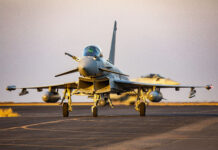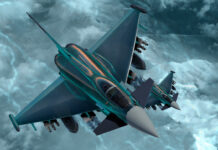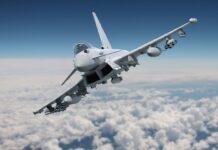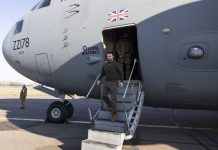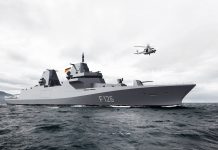The participation in the FCAS project, the new F-110 frigates and the 8×8 armoured fighting vehicle will boost Spain’s defence industry for the next decade.
According to data from the Spanish Defence Industry Association TEDAE, Spain’s defence industry declined by 7.5% in 2018, reached a total turnover of €4.9Bn and employed 20,519 professionals in 388 companies.
The majority of the products and services (60% valued €2.9Bn) are destined for export. The economic downturn in Spain forced companies to look for markets abroad since the Spanish defence budget was slashed by around 30% between 2008 and 2014. Europe (84.6%), the Middle East and North Africa (8.2%) and Latin America (3.57%) are the main export destinations.
Most of the defence turnover goes to a number of international consortia involving companies from other countries, including Germany, France, Italy and the UK and including programmes such as the EUROFIGHTER, the EJ2000 engine for the EUROFIGHTER, the A400M aircraft, the NH-90 helicopter and the MTR390 engine for the TIGER combat helicopter.
Sales per segment show the following distribution with regard to turnover: aeronautics (64%), land (19%), sea (16%) and space (1%). “At a national level, the change of Government in June 2018 is something that cannot be overlooked. This situation implied generating closer institutional relations with the purpose of moving forward with the approval of the so-called New Modernization Programmes of the Armed Forces”, Javier Pradere, Vice-Pesident of Tedae, told ESD.
In recent decades, efforts were made to position Spain among the few countries in the world that have an industrial fabric with companies offering the entire product cycle, from development to manufacturing, integration and maintenance.

Recently, five relevant developments occurred which are crucial for the Spanish defence industry:
First, Spain formally joined the Next Generation Weapon System (NGWS)/Future Combat Air System (FCAS) future European fighter programme. In Paris, Spain, Germany and France signed a Letter of Intent to launch the IA2 programme (research and technology activities and a demonstration phase) related to the conceptual phase of the FCAS project scheduled for May 2020.
A week earlier, the Spanish Government signed the implementation agreement for the first phase. “In a third agreement, Spain will be incorporated with a 33% stake equal to that of Germany and France”, Ángel Olivares, secretary of State of Defence told ESD. “For Spain, and our European partners, it is a strategic project that will involve a technological revolution, which will enable our companies to compete on equal terms with the rest of the European industry, even if they are smaller,” he said.
It needs to be remembered that Spain chose the technological company Indra to lead the Spanish part of the project, to the utter dismay of Airbus Spain.
Secondly, the Spanish medium companies GMV, Sener Aeroespacial and Tecnobit-Grupo Oesía reached an agreement to jointly head Spain’s participation in the Remote Carrier Technology part of the FCAS project which is part of the Next Generation Weapon System (NGWS) programme. The objective is to develop new technologies and concepts which allow a set of unmanned vehicles, some of them with ISTAR observation capability, to integrate and cooperate with the new FCAS combat manned aircraft.
Third, lackluster sales of the four-engine turboprop A-400M aircraft have promp-ted Airbus Defence and Space to cut 2,362 jobs until the end of 2021, 630 of them in Spain. There are expectations that the Spanish Air Force might replace its 85 F-18 HORNETs, but for the time being there are no official announcements in this regard. This comes as bad news for the Spanish defence industry as Airbus is its current “engine”.
Fourth, there is still no agreement on Spain`s future 8×8 armoured fighting vehicle. In December 2019, the MoD shocked the industry by rejecting the offer of General Dynamics European Land Systems-Santa Bárbara Sistemas (GDELS-SBS) to produce a first batch of 348 vehicles for €2,083M, covering the 2019 to 2030 fiscal periods. The Spanish companies Indra and Sapa were involved in the programme as well.
Following this decision, the Minister of Defence Margarita Robles announced that the Government would once again tender the contract.
However, an agreement to modify the vehicle`s 13 configurations could be reached in the coming weeks. The Spanish land systems industry is anxiously awaiting the launch of the 8×8 DRAGÓN contract, but the Ministry of Defence is still examining offers from French Nexter (VBCI vehicle), the Italian Iveco (FRECCIA) or the German-Dutch ARTEC consortium (BOXER), which would be a serious setback for the national industry.
Fifth, Expal Systems (Maxam’s lead defence business unit) and other ammunition companies like Instalaza are suffering from the ban on exporting ammunition to Saudi Arabia. EXPAL has initiated laying off 52 stuff and closing one production facility in Spain. “This announcement is a direct response to the decline in industrial production. The company has to adapt to the market situation, as it does not expect to return to the activity level of two years ago. The company is particularly affected by the Government’s changed export policy for defence equipment, which is having a significant impact on its exports to certain markets, in addition to the decline in orders from the Spanish Ministry of Defence“, Expal told ESD.
The EU Opportunity
Companies like Airbus DS, Navantia, Indra, Santa Bárbara Sistemas-General Dynamics European Land Systems (SBS-GDELS), Airbus Helicopters, Expal, Sapa, Urovesa, Escribano, Thales España, Hisdesat, GMV, Sener or Instalaza have a consolidated presence in the Spanish defence programmes or exports.

“The Spanish defence industry faces the challenge of actively participating in the consolidation of the European defence market, where further internationalisation opportunities will arise. The pace at which a single European defence market is being created must be changed so that those companies that are currently less accustomed to working in this environment get used to it,” says Secretary of State for Defence Ángel Olivares, highlighting the new opportunities that EU defence initiatives are likely to provide in the coming decade.
Spain is betting on projects under the PESCO (Permanent Structured Cooperation) framework. There are 18 projects in which Spain and its industry is interested: the training mission competence centre; the EU`s military systems test and evaluation centre; the deployable military disaster relief capability package; a crisis response operation core; the development of an integrated unmanned ground system; upgrading of maritime surveillance; the EURODRONE Male RPAS; TIGER Mk.II attack helicopters; secure software-defined radios; cyber threats and incident response information sharing platform; rapid cyber response teams and mutual assistance in cyber security; design of an EU operations command and control system; a European medical command; a network of logistics and operations support centres; military mobility; improved energy efficiency; sharing bases; and military radio navigation.
Participation in the EU’s defence measures is therefore a cornerstone of the current coalition government led by the socialist Pedro Sánchez and consisting of ministers from the Socialist Party and the radical left-wing Podemos.
The Minister of Defence is Margarita Robles, an independent Socialist Party politician with a background as a judge. During the last 18 Months, the Government has approved several major projects: the five new Navantia F-110 frigates (€4.3Bn); completing the four Navantia S-80 submarines (€1.7Bn), two new military satellites HISDESAT SPAINSAT and XTAR-EUR (€1.4Bn); the procurement of 23 new Airbus NH-90 helicopters (€1.3Bn); the modernisation of the Eurofighter fleet (€906M) by Airbus; and the modernisation of the CHINOOK helicopters (€1Bn). The latter project is being carried out by Boeing in Philadelphia, USA, and will therefore not have a major impact on the national industry.
However, other programmes are still in the pipeline: the aforementioned 8×8 armoured combat vehicles and their turrets, new jet fighters to replace the 85 F-18 HORNET and the Spanish Navy HARRIER or a new command radio system for the entire army.
 Spain’s Big Seven
Spain’s Big Seven
When looking at the seven most important Spanish defence companies, Indra certainly takes the lead. The Government, which owns 18.71% of the company’s shares, has contributed to this leading role condition by appointing the company as Spanish coordinator for the FCAS project, which has caused irritation within Airbus. The company supplies proprietary technology systems to the MoD. Indra employs around 40,000 people in 46 countries and has projects in over 140 countries. It mainly focusses on air surveillance systems, electronic defence, border surveillance, simulation, satellite communications and cyber defence.
Indra is involved in many leading European projects, such as the EUROFIGHTER, the A400M, the TIGER helicopter, the LEOPARD tank, the LHD ship, the F100 frigates and S80 submarines, the GALILEO system, the COPERNICUS programme and the INGENIO and PAZ satellite system and the Ocean 2020 project. It is also participating in the development of the 8×8 vehicle, the F-110 frigate, the NH-90 simulator and the Spanish Space Surveillance System, which will be one of the most powerful radars in Europe.
Navantia is the national shipbuilder wholly owned by SEPI, the Government’s industrial holding. It is a world leader in the design and construction of state-of-the-art warships and in ship repair and modernisation. It also designs and manufactures integrated platform management, fire control, command and control, propulsion and life support systems for all its products. Navantia employs 5,008 people and has a turnover of €850M. In addition to the S-80 submarines and the five F-110 frigates, Navantia is already building two Auxiliary Oiler Replenishments (AORs) for the Royal Australian Navy, a strategic customer for Navantia, from which it has received orders worth €2.4Bn in recent years for two Landing Helicopter Docks (LHDs) and three Air Warfare Destroyers (AWDs).
The President of Navantia, Susana de Sarriá, stresses the “pride of Navantia and of the Spanish industry as a whole in the international success of the company in Australia”. Another important contract for Navantia is the export of five corvettes to Saudi Arabia for €1.8Bn, the largest export contract in the history of Spain’s shipyards. The programme started in January, 2019 and the last ship is due to be commissioned in 2022. In addition, Navantia will be responsible for life cycle management for five years with the option for five additional years.
As far as its impact on employment is concerned, it is calculated that the contract will create almost 6,000 direct and indirect jobs annually over the next five years. The corvettes for Saudi Arabia are based on Navantia’s AVANTE 2200 design, which was sold to Venezuela a decade ago. Navantia has its main production facilities in Ferrol (La Coruña), San Fernando and Puerto Real (Cádiz) and Cartagena.
Airbus Defence and Space, the European leader in aerospace, employs the majority of Airbus’ Spanish workforce, with nearly 7,700 employees at five sites. Airbus is one of the world’s leading manufacturers of military transport aircraft and plays a leading role in the twin-engine EUROFIGHTER combat aircraft. The San Pablo and Tablada sites in the Seville area are the epicentre of Airbus’ military transport business, with final assembly lines for the four-engine turboprop A- 400M aircraft and the twin-engine C-295 and CN-235 transport aircraft. Seville is also home to the International Training and Delivery Centre for Airbus military aircraft. Getafe (Madrid) is the site of the A-330 MRTT Conversion Centre, where the refuelling and military avionics systems needed to convert the Airbus A330s into multipurpose tankers are being installed. Airbus also manufactures some parts for the EUROFIGHTER at Getafe. The replacement of 85 F-18 fighter aircraft over the next three to five years is one of the pillars for the next years. “The EUROFIGHTER (Tranche 3) is the most likely choice to replace these old fighters,” the MoD told ESD.
The Spanish Government owns 4.17% of the company’s shares. However, declining exports of the A-400M will affect the company in the coming years.
Santa Bárbara Sistemas-General Dynamics European Land Systems (SBS-GDELS) employs more than 1,000 highly qualified personnel at four locations in Trubia (Asturias), Seville and Madrid. The product portfolio includes tracked vehicles (ASCOD family), wheeled armoured vehicles such as the PIRANHA, artillery systems (SIAC howitzer) and large calibre ammunition. GDELS has also received a licence to manufacture the LEOPARD 2E main battle tank or the SPIKE rocket for the Spanish Army.
SBS-GDELS expects to be awarded the contract for the new 8×8 armoured vehicle based on the PIRANHA 5; the programme is crucial to the company. Spanish Army officers have already seen the first demonstrators at the SBS-GDELS facility.
Expal Systems is MAXAM’s lead defence business unit and has more than 1,300 employees, mainly in Spain but also in other 10 production centres in Italy, Bulgaria, Belarus, Denmark and the US. EXPAL’s portfolio includes weapon systems, ammunition and propellants, systems and technology applications, as well as aeronautical systems and concepts for maintenance, demilitarisation and terrain clearance. The company has one of the largest ammunition portfolios in the market and develops its own family of extended-range (ER) artillery ammunition based on base bleed technology, which provides ranges of up to 20 km with 105mm and up to 40 km with 155mm, depending on the platform. EXPAL’s 105mm and 155mm artillery ammunition is used by more than 30 armies and is compatible with all NATO howitzers. EXPAL’s ammunition is fully compatible with the most important naval guns such as 40mm and 76mm in all its variants, as well as the industry-leading 5’’/127mm gun mountings. The Spanish company supplies more than 20 air forces worldwide with MK type ammunition (now in its 80 series), training bombs of type MK-76, BDU-33 and MK-22 as well as the penetration bomb BPG 2000 with an integrated precision-guided system.
The Airbus Helicopters plant in Albacete started operations 11 years ago.
To complement production sites in France and Germany, the Albacete plant will become the company’s centre of excellence for the manufacture of large component assemblies. The Spanish plant will specialise in the production and integration of the rear fuselages of all Airbus helicopters for the global market. TIGER HAD/E (attack) and NH-90 (tactical transport) helicopters for the Spanish Army are being assembled in Albacete. Two years ago, the Spanish Government approved the acquisition of a second tranche of 23 NH-90 CAIMAN helicopters for €1.3Bn. The first tranche was 22 NH-90s. The MoD predicts a fleet of 108 NH-90 helicopters – 48 for the army, 28 for the navy and 28 for the air force.
ITP Aero is currently an Original Equipment Manufacturer (OEM) in three important European defence consortia: firstly, in the EUROJET Turbo GmbH (Eurojet) consortium, responsible for the EJ200 engine and the EUROFIGHTER fighter jet; secondly, in EPI EUROPROP International GmbH (EPI), responsible for the TP400 turbo-propeller, the world’s most powerful propeller, for the long-distance military transport aircraft Airbus A400M; and finally, in MTU Turbomeca Rolls-Royce ITP GmbH (MTRI), responsible for the MTR390-E rotorblades for Airbus Helicopters’ TIGER, Europe’s most advanced attack helicopter. In 2017, the Spanish Government approved the acquisition of ITP Aero by Rolls Royce. In 2019, Indra tried to acquire ITP Aero from Rolls Royce but to no avail.
Since 2003, more than 1,200 engines have been delivered to the fleets of various nations. In addition, ITP Aero is the main supplier for engine maintenance to the Spanish armed forces.
Other Important Actors
Beside these seven large companies, there are many other smaller companies that play a role in Spanish industry, participate in Spanish programmes or export all over the world. These include:
Thales España, a subsidiary of the French technology giant, with more than 1,200 employees in Spain. It is specialised in radio communications for the Spanish Armed Forces and hopes to secure another contract for the future command and control system.
Hisdesat, founded in 2001, is the Government’s satellite services operator.
Babcock Spain, the former Inaer, was acquired by the British. Babcock Spain modernised the AB-212 helicopters of the Spanish Navy (with SENER) and customised and modernised the AS332 helicopters of the Spanish Army, the COUGAR 532 for UME (Emergency Unit) and S76C of the Spanish Air Force. Babcock hopes to be contracted for the Spanish Air Force training programme, similar to the French Air Force training programme.
Saes has 25 years of experience in the naval industry and specialises in underwater acoustics and electronics, systems for submarines, ships and anti-submarine warfare air platforms.
Urovesa designs and manufactures off-road special vehicles for the military. Its primary vehicle VAMTAC has been sold to the Spanish Army and exported to the Middle East and South America. Portugal also signed a contract through NATO to buy 139 VAMTAC ST5 for €60.8M.
Sener is engineering and technology company and the Spanish partner of General Atomics Aeronautical Systems (GA-ASI) in the acquisition of four MQ-9 REAPERs by the Spanish Air Force next year. It will take part of the Remote Carrier Technology Pillar of the NGWS/FCAS project.
Tecnobit is a company active in aviation, optronics, tactical communications, secure communications, aerospace and simulation. It will also participate in the Remote Carrier’s NGWS/FCAS project. Within the optronics sector, it is one of the most important global companies and the leader in Spain. The TGOR software-defined-radio is competing to be part of the Spanish Armed Forces.
Instalaza is an Armed Forces supplier with four main products: the ALHAMBRA hand grenades and rifle grenades; the ALCOTAN system for the infantry which is fireable from confined spaces; the C-90 bazooka family and night vision devices. It exports to different countries in the Middle East, Europe and around the world.
Escribano is an engineering and manufacturing company and a systems integrator with 300 employees. A new remote control station, an infrared search and track (IRST) system, guided rocket systems, drone-hunter systems and simulation are among its products
GMV is specialising in the engineering, design, development, integration, testing, verification and maintenance of defence and security systems. It is taking part in the NGWS/FCAS project.
Esteban Villarejo



